Information and exercise leaflet for patients and carers
What are the causes of ankle pain?
Ankle pain can occur for many different reasons, including following an accident, overuse or osteoarthritis.
Whether the pain is coming from the joint or the soft tissues, treatment in the form of self-help, as described in this leaflet, can often help to improve the pain and stiffness that you may be feeling.
Do I need any tests?
Many ankle conditions do not need any tests such as x-rays or scans. Doing some initial exercise and other forms of treatment described in this leaflet, can often help to reduce pain and swelling. If your symptoms remain unchanged following this, then you may need to seek further medical attention.
Should I take painkillers?
Doing exercise with a painful ankle can be difficult, especially in the initial stages. If your pain is reduced by taking painkillers this can make it easier to move your ankle, and this movement can help your ankle to recover more quickly. However, it is important to discuss this with your GP, especially if you are taking any other medication. What about normal activity (like work and sports) You will recover faster if you can maintain as normal a level of activity as you can, but you may need to modify what you can do if pain is not controlled well enough with painkillers. Activity modification rather than activity avoidance is the key. Try to stay active and remember to keep moving. At work you may need to speak to your manager about the options available to you for activity modification.
How do I know if my activities are causing a painful reaction?
Pain is a normal experience and can be expected as you start to move the ankle. All forms of exercise should be done within what you consider your ‘acceptable tolerance’ level. It is common to get a painful reaction if too much load is put through the ankle. If this pain is more than 5/10 (with 10 being the worst pain imaginable) and lasts for more than 24 hours check what you have been doing and ease back.
Once this has settled you can start to gradually introduce your activities and exercises again. If you have a mild aggravation (pain is less than 5/10) and this settles within 24 hours then keep going with your exercises and gradually return to full activities.
What is the aim of Physiotherapy?
The aim of physiotherapy is to increase joint mobility and strength and to reduce pain.
General measures to help treat ankle pain:
Exercise
Regular movement of the ankle can help to reduce pain and stiffness of the tissues or joint. It can also help to gradually build up the condition and strength of the muscles that are either painful or that help to support the ankle joint.
Please see the suggested exercises at the end of this leaflet for some initial guidance on what type of exercises to do.
Weight control
If you are overweight, try to lose some weight as the extra burden placed on your ankles can make symptoms worse. Even a slight reduction in weight can make quite a difference.
Poor diet, high cholesterol and diabetes can also be linked to painful joints and muscles.
Using Ice or Heat
Ice and heat are a safe, effective and cheap way to help to relieve pain or swollen joints. There are many different types of cool and heat packs but a simple option is to use a hot water bottle or a packet of frozen peas. Some people alternate between the two or some prefer one or the other.
Ice is recommended for inflamed joints after it has been checked by a clinician and know why your joint is swollen. If the joint looks swollen and red it can be applied several times a day for 10 minutes at a time wrapped in a damp towel.
People with reduced sensation, numbness or circulatory problems should discuss the use of ice or heat with a healthcare professional prior to using them.
Ice and heat can burn skin therefore people should always use a towel to cover the area and check their skin regularly for any changes and signs of burning. A damp towel is more effective when applying ice.
Always mark the packet of frozen peas before putting them back in the freezer as they would be unsafe to eat after being defrosted numerous times.
Warning Signs
If you develop new or worsening symptoms, if you are unwell with the pain, or under the age of 16 years, seek medical advice.
The following symptoms are very rare, but if you suddenly develop any of them, you should seek urgent medical attention at your local Urgent Care Centre.
- Sudden onset of Achilles pain, with a “pop” or snapping sound/sensation.
- Inability to weight-bear through the foot/ankle.
- New significant injury to the leg/foot/ankle.
- Constant night pain in the foot/ankle (that prevents rest/sleep).
- Significant swelling, colour change or temperature change in the foot/ankle or extending up the leg.
- Lumps in the foot/ankle.
- Signs of infection i.e. night sweats that are out of the ordinary, high temperature and feeling unwell.
- Unexplained weight loss
If your symptoms fail to improve within 6-8 weeks with this regime you should contact your doctor for a physiotherapy referral.
If your symptoms are improving (even slowly), continue for up to 3 months.
Exercises for ankle pain
Do not work into pain but it is ok for your muscles to feel tired. If the number of repetitions or length of the hold is too long, back off slightly, but aim to build up to the stated level.
Use the reaction rules to guide your exercise intensity. If pain is stopping you engaging in rehab, you should speak to your GP about pain relief promptly.
Flare-ups may happen; if it doesn’t settle in a couple of weeks, then seek further advice
Level 1 – start off with low numbers of the exercise and gradually build up your hold time or your repetitions.
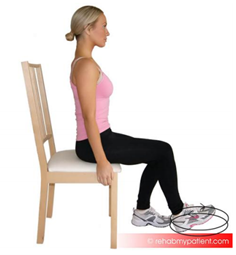
Ankle Circles Sitting
Sit down and move your ankles around in circles both anticlockwise and clockwise. This is a great mobility exercise to the ankle, and very useful for ankle stiffness following a sprain.
Perform for 60 seconds
Repeat 10 times
3 times daily

Heel Raises Sitting
Sit upright on a chair, with your feet flat on the floor. Slowly raise your feet up onto your toes. Hold, and gradually control the movement back down to the starting position. This is a useful calf pump exercise to improve circulation to your lower legs, as well as improving mobility of the ankle joints.
Perform 10 times
Repeat twice
3 times daily
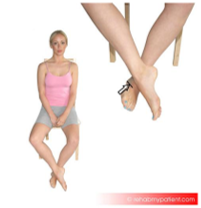
Self-Resisted Eversion
Sitting on a chair, cross your feet keeping your heels on the floor. Push the outside of your feet against each other. This is a strengthening exercise for your ankles.
Hold for 5 seconds
Repeat 10 times
3 times daily
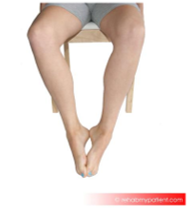
Self-Resisted Inversion
In sitting, place your toes together, pressing inwards and upwards against the resistance of each other. This is a strengthening exercise for the ankle.
Hold for 5 seconds
Repeat 10 times
3 times daily
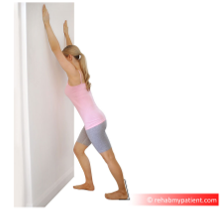
Self-Resisted Inversion
Stand facing a wall, with your hands resting on the wall. Move one leg forwards and gently bend your knee, this will be the passive leg and just there for support. The leg you will be stretching will remain straight with your heel on the ground and a doorstop wedge under the ball of your foot, the thickest side under the big toe side and the thin end under the little toe side. You should feel a stretch to the leg at the back, in the calf muscle (known as the gastrocnemius).
Hold for 30 seconds
Repeat 10 times
3 times daily
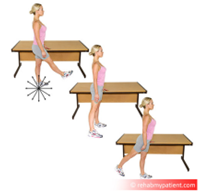
One Leg Clocks
Stand on your injured leg. Swing your other at different directions, as if you were going around a clock. Hold onto support if required. This exercise challenges the injured leg that stabilises the body while your non-injured leg moves in different directions.
Perform for 30 seconds
Repeat 10 times
3 times daily
Level 2 – If exercises at level 1 feel easy to complete you can try the following exercises – ensure you have something to hold onto for balance and to prevent falls.

Calf Raises Two Legs
Stand upright and hold onto a wall/table for balance if required. Slowly raise up onto your toes and control the movement back down. This exercise will strengthen the calf muscles and ankle joints.
Hold for 10 seconds
Repeat 10 times
3 times daily
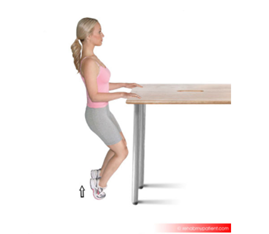
Calf Raises with Knee Bent Two Legs
Stand up with your knees bent and rise up onto your toes and hold. Slowly control the movement back down. This is a strengthening exercise for the soleus (lower calf) muscle.
Perform 10 times
Repeat twice
3 times daily
If these self-help tips do not help your symptoms within 6-8 weeks then a Physiotherapy referral may help to improve your joint mobility, strength, and reducing pain.
What actions can I take to improve my health?
Evidence tells us that making healthy lifestyle choices can have a big impact on influencing problems with your muscles and bones and can play a major role in your overall health. Some of the most effective areas to address are below: (click on the links)
Maintaining a healthy weight - www.nhs.uk/live-well/healthy-weight/
Increasing levels of physical activity - http://www.nhs.uk/live-well/exercise/
Avoiding poor sleep patterns - www.nhs.uk/live-well/sleep-and-tiredness/how-to-get-to-sleep/
Reducing alcohol consumption - https://www.nhs.uk/live-well/alcohol-support/calculating-alcohol-units/
Stopping smoking - http://www.nhs.uk/live-well/quit-smoking/
Maintaining a healthy mind - http://www.nhs.uk/conditions/stress-anxiety-depression/
The good news is that you are able to influence lots of these by modifying your lifestyle. Therefore it is important that you consider addressing these areas alongside your current treatment.
You may wish to discuss any of these factors with your treating clinician who will be able to work with you and guide your long term management and support you to improve your wellbeing.
There will be information about the local services that exist within the waiting areas of the physiotherapy department and your treating clinician will be able to help signpost you to appropriate services.
The websites listed below give more information on local services available:
• Blackburn and Darwen - https://refreshbwd.com/
• East Lancashire - http://www.upandactive.co.uk/
• Public Health England https://www.gov.uk/government/organisations/public-health- england
You can download a printable version of this information here.
Please note this is a PDF and does not meet accessibility needs.


